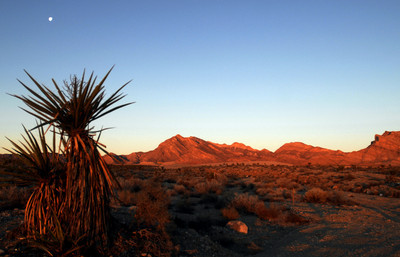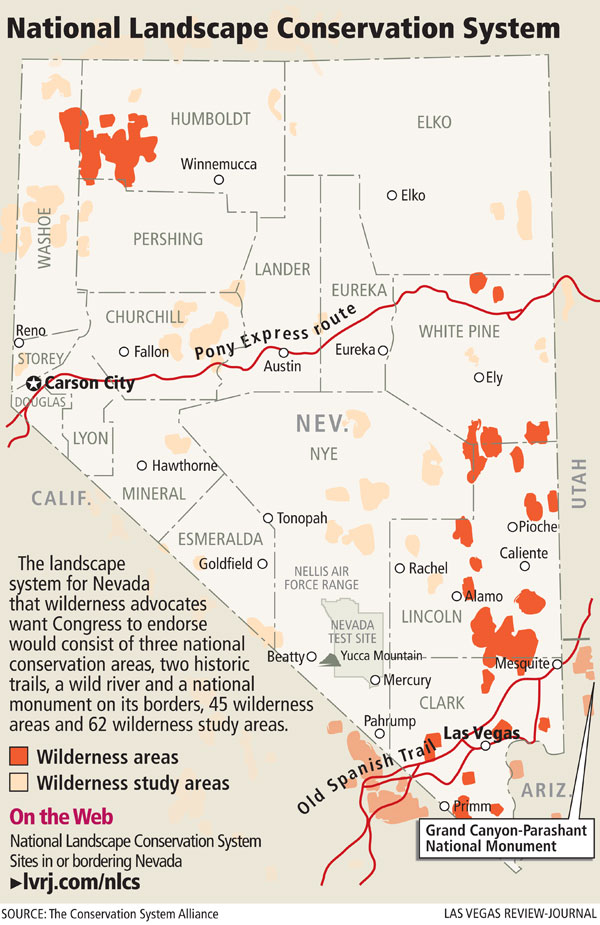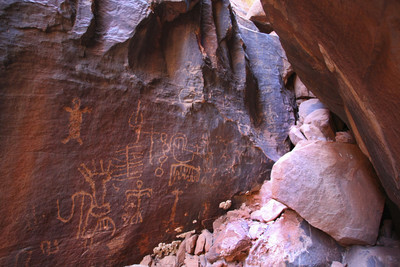Land preservation plan includes Red Rock Canyon
Brian O'Donnell has hiked the back country of Nevada's wildlands and he's been to Red Rock Canyon at least 100 times.
He believes the landscape that makes this part of the West what it has been for centuries -- sweeping views of bald-faced cliffs, American Indian etchings on sandstone walls and raw desert decked with yucca plants and Joshua trees -- should remain untouched for future generations to experience.
He fears, though, that won't happen for many places such as Red Rock Canyon unless Congress authorizes the National Landscape Conservation System.
Doing so would make Nevada's three conservation areas, along with its 45 wilderness areas, 62 wilderness study areas, and 26 million acres of public lands in a dozen Western states, protected in a permanent system.
"It would be on par with the National Park Service system and the National Wildlife Refuge system," said O'Donnell, executive director of the National Conservation System Foundation, which is backing its inclusion in a massive lands bill. "People would know what to expect when they visit these areas."
And that would be to not see vandalism or scars on the landscape from off-road vehicle travel.
The landscape system was established administratively by President Bill Clinton in 2000 and was kept intact by the Bush administration without guarantees by Congress that the Bureau of Land Management would forever make it a priority to fund protection of the system from artifact looting, vandalism, invasive plants and damage to wildlife habitat, cultural sites and natural resources.
"Without congressional authorization, you're always beholden to the occupant of the White House," O'Donnell said Thursday from Durango, Colo.
"We're fortunate today we have a strong supporter there who will ensure this will exist," he said of President Barack Obama.
The lands bill passed the Senate in January.
The House tried to pass it Wednesday by a two-thirds majority but fell two votes short.
The Senate plans to rework the bill next week and send it back for reconsideration as a measure that with bipartisan support is likely to pass by a simple majority in the House.
One who voted against the bill Wednesday was Rep. Dean Heller, R-Nev. His district covers 105,000 square miles of mostly federal land.
Heller said he couldn't support the measure because it was too vague and would give the federal government authority to close access to public lands.
Heller's office later expanded on his view, saying that in addition to trumping access rights, the bill would make conservation the BLM's primary focus, putting it out of balance with the bureau's purpose for maintaining multi-use lands. That means energy zones, mining claims and grazing would take a back seat as the BLM redirects its priorities, his staff asserted.
But on the day the House defeated quick passage of the omnibus lands bill, Interior Secretary Ken Salazar issued orders to spur renewable energy developments on public lands.
Salazar said that can be done without disrupting sensitive environments or the scenic landscape through careful planning with other agencies, even though transmission line corridors would cover more than 5,000 miles of public land.
"If you just take the solar energy that we could produce from the Southwestern states, just the solar energy, and you were to go to a planning process where essentially you take off those lands that have ecological wildlife habitat sensitivities, you then reduce the map of public lands available for solar power plant placement by a very, very huge percentage," Salazar said.
"But even after that reduction, the remaining zones for development tell us today that we can produce about 88 percent of all of the energy needs of the Western United States just from solar energy alone.
And when you add in wind, it surpasses 100 percent of the current needs."
Noticeably missing from the list of Nevada sites in the National Landscape Conservation System are the rugged lands around the historic mining town of Gold Butte, 65 miles northeast of Las Vegas.
Like Red Rock Canyon National Conservation Area, the remote terrain around Gold Butte features rock art, historical sites and stunning views of the Old West. It is a popular destination for off-highway vehicle enthusiasts and environmentalists alike and has been pitched to be Nevada's next national conservation area. To do so would mean closing only 70 miles of roads while keeping more than 480 miles open under a BLM proposal.
Although former Rep. Jon Porter, R-Nev., didn't push for Gold Butte to be part of the lands bill that the House considered after his departure, O'Donnell believes it "would be an outstanding addition to the National Landscape Conservation System."
He doesn't foresee Gold Butte would be considered for the bill when the Senate revisits it next week.
And a spokesman for Senate Majority Leader Harry Reid said Thursday he has no plans to add it to the lands bill.
Nevertheless, O'Donnell is optimistic that there will be "other opportunities to get it through this Congress" as a measure calling for creating a Gold Butte national conservation area.
Rep. Dina Titus, D-Nev., who defeated Porter, voted for the omnibus lands bill Wednesday and "plans to support it when it comes up again," her spokesman, Andrew Stoddard said.
"As far as Gold Butte, Congresswoman Titus is focused on it and understands the importance of the issue to the community," Stoddard said.
"She wants to ensure that all the stakeholders are brought to the table to build consensus on a course of action to move forward."
Whether that action leads to creation of Gold Butte conservation area remains to be seen, Stoddard said.
"We will have to see what comes out of discussions first with all of those who will be affected by any action that is taken. She wants to get everyone involved to discuss what the best plan is."
Contact reporter Keith Rogers at krogers@reviewjournal.com or 702-383-0308.
National Landscape Conservation System:
Sites in or bordering Nevada
Gold Butte audio slideshow
Conservation System Alliance



















